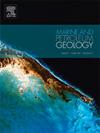Multi-stage dolomitization controlled by sedimentary facies and basement faults: Insights from the Middle Permian Maokou Formation of the Eastern Sichuan Basin, SW China
IF 3.7
2区 地球科学
Q1 GEOSCIENCES, MULTIDISCIPLINARY
引用次数: 0
Abstract
The Middle Permian Maokou Formation in China's eastern Sichuan Basin has undergone multiple episodes of dolomitization, recrystallization, and cementation. However, a consensus on the controlling factors for dolomite formation has yet to be reached. This study adopted a multidisciplinary approach, encompassing petrological, geochemical (C-O-Sr stable isotopes, trace elements, and rare earth elements), and fluid inclusion thermometry analyses to determine the spatial distribution characteristics and diagenetic influencing factors of various dolomite types. Core, outcrop, and thin-section observations have identified three types of replacive dolomites and one type of cementing dolomite: very fine crystalline, nonplanar-a to planar-s dolomite (RD1); fine to coarse crystalline, nonplanar-a to planar-s dolomite (RD2-a); fine to coarse crystalline, planar-e dolomite (RD2-b); and medium to coarse crystalline, nonplanar saddle dolomite (CD). All dolomites exhibit more negative δ13C and δ18O values than the host limestone, with 87Sr/86Sr ratios exceeding the range of Permian seawater. RD1 has negative or no anomaly in the Eu element and shows higher Sr content with lower Ba content, indicating that it was not affected by hydrothermal fluids. RD2-a and CD show positive anomalies in Eu, with lower Sr content and higher Ba content, indicating that both were affected by hydrothermal fluids. RD2-b, although showing negative or no anomaly in Eu, has fluid inclusion homogenization temperatures comparable to CD and also has less Sr with more Ba, suggesting that its formation also involved hydrothermal fluids. All dolomites exhibit a clear negative anomaly in the Ce element. By synthesizing petrological and geochemical findings, a multi-stage dolomitization model was proposed, which includes seepage-reflux, thermal convection, and hydrothermal dolomitization, reflecting the formation mechanisms of various dolomite types. Before the activation of the basement faults (SQ1 ∼ SQ2-TST), RD1 was formed by limited seepage-reflux dolomitization in low-energy shoals and small-scale confined environments on the periphery of open seas, with dolomitization fluids being contemporary seawater and a small amount of meteoric water. In the early stage of basement fault activity (SQ2-HST), abnormal geothermal temperatures promoted the thermal convection dolomitization between hydrothermal fluids and external cold contemporary seawater in high-energy and low-energy shoals, leading to the formation of RD2-a, with dolomitization fluids being contemporary seawater and a small number of hydrothermal fluids. In the middle stage of basement fault activity (SQ3), silica-rich hydrothermal fluids rose along the faults and mixed with contemporary seawater, replacing the previously formed dolostones and host limestone to form RD2-b. In the peak stage of basement fault activity (the end of Guadeloupe), deep hydrothermal fluids were fully transported in high-permeability layers and precipitated dolomite cement (CD) in cavities and fractures near the basement faults. The dolomitization fluids for both RD2-b and CD were hydrothermal fluids mixed with a small amount of contemporary seawater. The model delineated within this paper encapsulates the principal controlling factors governing dolomite formation, thereby facilitating a comparative analysis of the genesis of dolomites from various global locales.
沉积相与基底断裂控制的多期白云化作用——四川盆地东部中二叠统茅口组的启示
中国四川盆地东部的中二叠统茅口组经历了多次白云岩化、重结晶和胶结过程。然而,关于白云岩形成的控制因素尚未达成共识。本研究采用多学科方法,包括岩石学、地球化学(C-O-Sr 稳定同位素、微量元素和稀土元素)和流体包裹体温度测定分析,以确定各种白云岩类型的空间分布特征和成岩影响因素。通过岩芯、露头和薄片观察,确定了三种类型的置换白云岩和一种类型的胶结白云岩:极细晶、非平面-a 至平面-s 白云岩(RD1);细至粗晶、非平面-a 至平面-s 白云岩(RD2-a);细至粗晶、平面-e 白云岩(RD2-b);以及中至粗晶、非平面鞍状白云岩(CD)。所有白云岩的 δ13C 和 δ18O 值都比主石灰岩更负,87Sr/86Sr 比值超过二叠纪海水的范围。RD1 的 Eu 元素为负或无异常,Sr 含量较高,Ba 含量较低,表明其未受热液影响。RD2-a 和 CD 的 Eu 元素呈正异常,Sr 含量较低,Ba 含量较高,表明两者都受到热液的影响。RD2-b 虽然在 Eu 方面显示负异常或无异常,但其流体包裹体均化温度与 CD 相当,而且 Sr 含量较低,Ba 含量较高,这表明其形成过程也受到热液的影响。所有白云岩都表现出明显的 Ce 元素负异常。通过综合岩石学和地球化学研究结果,提出了包括渗流-回流、热对流和热液白云岩化在内的多阶段白云岩化模型,反映了不同类型白云岩的形成机制。在基底断层激活之前(SQ1 ∼ SQ2-TST),RD1是在开阔海域外围的低能量滩涂和小尺度圈闭环境中通过有限的渗流-回流白云岩化作用形成的,白云岩化流体为当代海水和少量陨石水。在基底断层活动的早期阶段(SQ2-HST),异常的地热温度促进了高能滩涂和低能滩涂中热液与外部低温的当代海水之间的热对流白云化作用,从而形成了RD2-a,白云化流体为当代海水和少量热液。在基底断层活动的中期阶段(SQ3),富含二氧化硅的热液沿断层上升,与当代海水混合,取代了之前形成的白云石和主岩灰岩,形成 RD2-b。在基底断层活动的高峰阶段(瓜德罗普岛末端),深层热液在高渗透层中充分运移,并在基底断层附近的空洞和裂缝中析出白云石胶结物(CD)。RD2-b 和 CD 的白云石化流体都是热液与少量当代海水混合而成。本文所描述的模型囊括了白云岩形成的主要控制因素,从而有助于对全球各地白云岩的成因进行比较分析。
本文章由计算机程序翻译,如有差异,请以英文原文为准。
求助全文
约1分钟内获得全文
求助全文
来源期刊

Marine and Petroleum Geology
地学-地球科学综合
CiteScore
8.80
自引率
14.30%
发文量
475
审稿时长
63 days
期刊介绍:
Marine and Petroleum Geology is the pre-eminent international forum for the exchange of multidisciplinary concepts, interpretations and techniques for all concerned with marine and petroleum geology in industry, government and academia. Rapid bimonthly publication allows early communications of papers or short communications to the geoscience community.
Marine and Petroleum Geology is essential reading for geologists, geophysicists and explorationists in industry, government and academia working in the following areas: marine geology; basin analysis and evaluation; organic geochemistry; reserve/resource estimation; seismic stratigraphy; thermal models of basic evolution; sedimentary geology; continental margins; geophysical interpretation; structural geology/tectonics; formation evaluation techniques; well logging.
 求助内容:
求助内容: 应助结果提醒方式:
应助结果提醒方式:


